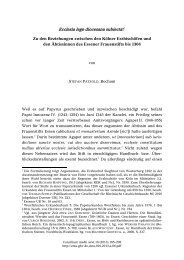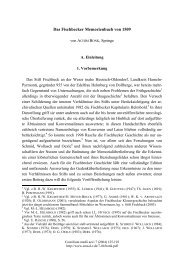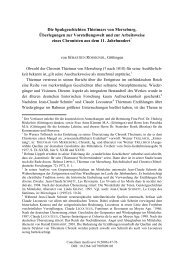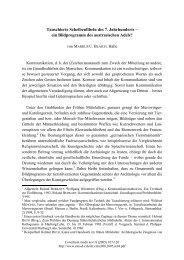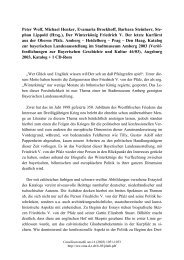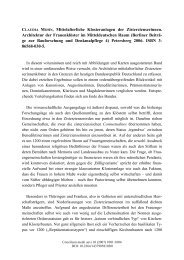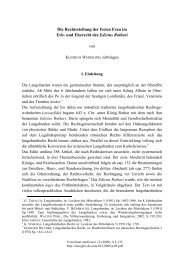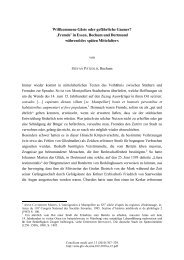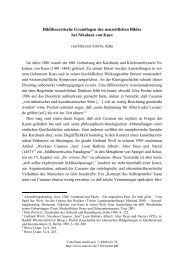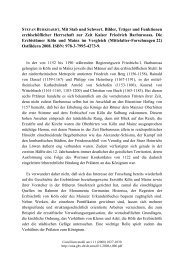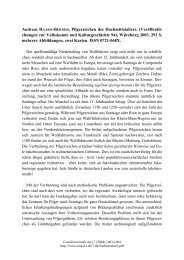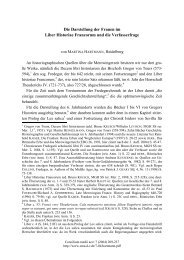Rabanus Maurus - Concilium medii aevi
Rabanus Maurus - Concilium medii aevi
Rabanus Maurus - Concilium medii aevi
You also want an ePaper? Increase the reach of your titles
YUMPU automatically turns print PDFs into web optimized ePapers that Google loves.
FEE-ALEXANDRA HAASE: Rhetoric as praise of the emperor<br />
a higher or even the highest position, but also contain advises for general lifeconduction.<br />
Derived from Secundus Symphosius and an anonymously written disputation<br />
between Hadrian and Epictetus, the Disputatio regalis et nobilissimi juvenis Pippini<br />
cum Albino scholastico (The dispute of the royal and most noble young man Pippin<br />
with the teacher Albinus) provides another pedagogical dialogue, this time with the<br />
son of Charlemagne. The main didactic method used by Alcuin was the question and<br />
answer scheme. We find this in the teachings and in the dialogues. It can be considered<br />
as a rhetorical concept. The dialogue between Pippin and Alcuin is composed in<br />
question and answer. If we compare now the dialogues between Pippin and Alcuin as<br />
well as between Charlemagne and Alcuin, we first have to ask about their origin, time,<br />
purpose and authenticity. So the first dialogue could have been only homage to Pippin<br />
later made by his son Charlemagne in order to establish him in the annals as the<br />
legitimate emperor following Pippin. 22 While we find as topic of the dialogue between<br />
Pippin and Alcuin the definition of main elementary things such as things and abstract<br />
values in an encyclopaedic approach, which establishes his text in one tradition of<br />
educational literature with Comenius’ Orbis pictus, the dialogue with Charlemagne<br />
focuses only on rhetoric in the tradition of the ancient rhetorical concepts and allows<br />
derivations only as exempla. Alcuin invokes Charlemagne with the title ‘rex’ and is<br />
respected by the king for his ability to open the subtle value of rhetoricae artis vel<br />
dialecticae. In the dialogue with Pippin no special invocation of the king is made. So<br />
this demonstrates the importance of the dialogues to represent the king Charlemagne,<br />
while Pippin is the basic elementary background expressed with the encycopedic<br />
approach of the text. His son is object of rhetorical honor when Alcuin says, that God<br />
made Charlemagne great (magnus) and beautiful (beatus): ‘Magnum te faciat Deus et<br />
vere beatum, domine mi rex […].’<br />
22 For the editorial history of Pippini Regalis et Nobilissimi Juvenis Disputatio cum Albino Scholastico<br />
see: A text edition of Pippini Regalis et Nobilissimi Juvenis Disputatio cum Albino Scholastico was<br />
made by Jean Lauand: Pippini Regalis et Nobilissimi Juvenis Disputatio cum Albino Scholastico (PL<br />
101, 975-980). One copy of the Disputatio Pippini cum Alcuino is the Ms 808 in the Österreichische<br />
Nationalbibliothek, Vienna. Pippini Regalis et Nobilissimi Juvenis Disputatio cum Albino Scholastico<br />
(PL 101, 975-980). Monitum pr<strong>aevi</strong>um. Cl. Quercetanus Disputationem quae sequitur edidit juxta<br />
exemplar impressum Hamburgi anno 1615. In codice ms. Salisburgensi 900 annorum eadem<br />
Disputatio exstat media inter epistolas et carmina Alcuini, absque tamen auctoris nomine; e quo<br />
lectiones variantes adnotavimus. Modern print editions: Philosophus Secundus; Publius Aelius<br />
Hadrianus; Epictetus; Albinus Diaconus, Altercatio Hadriani Aug. et Epicteti philosophi; Item<br />
Disputatio Pippini et Albini scholastici. Haer nova; illa auctior prodit. Ed. H. LINDENBROG. Hamburgi<br />
1615; Flaccus Alcuinus, Gespräch des jungen hochedlen Königssohns Pippin mit seinem Lehrer<br />
Albinus [Disputatio Pippini et Albini]. 1880.<br />
13



